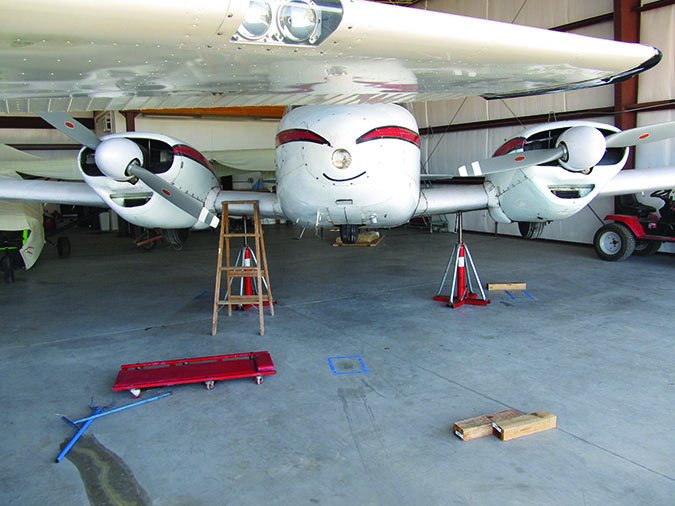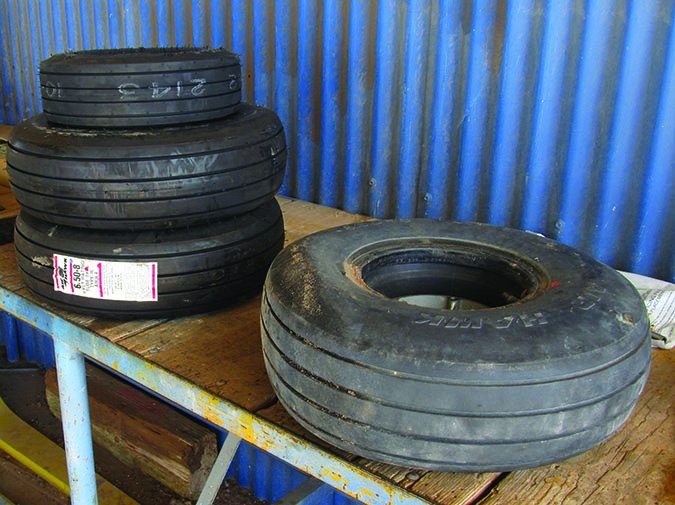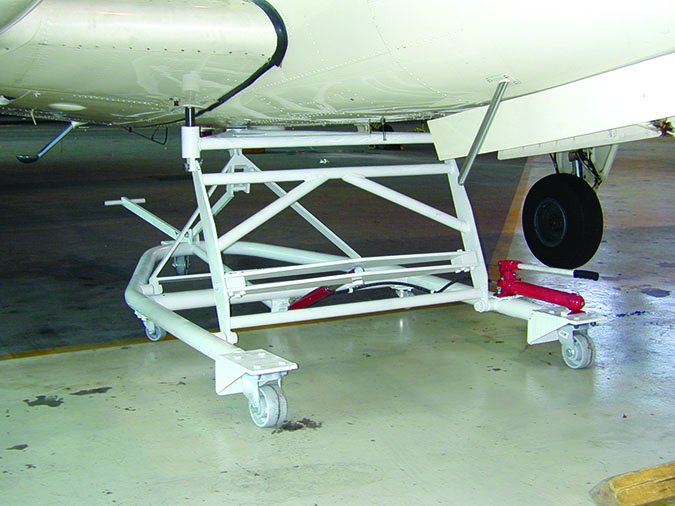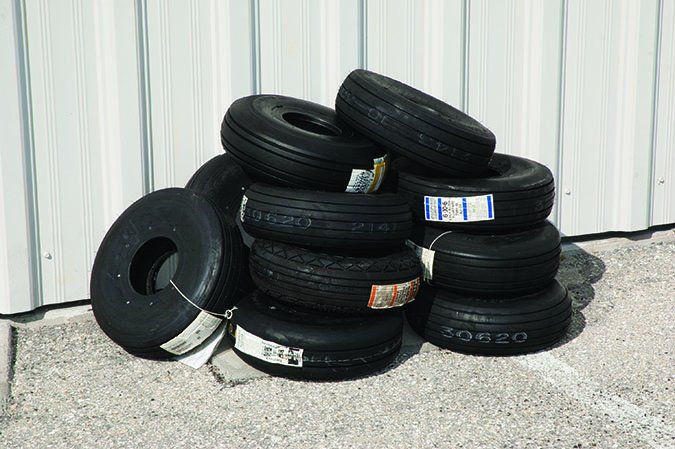While generally round and black in color, that’s almost all the characteristics aircraft tires have in common with their automotive siblings. In fact, a major difference is the construction and materials used in their manufacture. Aircraft tires and tubes primarily incorporate natural rubber while automotive tires use synthetic compounds extensively. Aircraft tires are designed for a very specific job and are part of the landing gear system on almost every aircraft.
Properly serviced tires play a major role in the safe operation of an aircraft, and neglected tires can contribute to an accident. Since the aircraft tire is part of the landing gear system, it’s required to flex as much as three times the rate of an automotive tire during normal operation, especially landings. This flexing of the aircraft tire and the proper shock absorption of the landing gear system depend upon tires that are in good condition, of the proper size/ply rating and properly inflated. Which brings us to our first tip.
1. Proper Inflation
The key to obtaining best performance from an aircraft tire is maintaining proper inflation. Proper inflation according to your specific aircraft requirements— no matter how difficult it may be with wheel pants installed—is a must. The proper pressure can be obtained from an aircraft maintenance manual and may also be listed in an operating handbook for your aircraft. It is not possible to eyeball a tire and determine it is inflated to the proper pressure. Instead, a properly calibrated pressure gauge (preferably a dial or digital type) used when the tire is cool is a must.
Since most aircraft tubes are still made from natural rubber, the air inside them slowly diffuses through the rubber and escapes to the atmosphere during the tube’s entire life. This diffusion is normal but requires that the tire/tube be checked and serviced every few days to replenish the lost pressure. The normal daily pressure loss is in the area of two percent of the normal operating pressure—if this leakage exceeds five percent, the tire/tube should be removed from service and investigated. Tires/tubes inflated for the first time after a new installation should be allowed to grow and stabilize for at least 12 hours, then pressure checked prior to being placed in service.
The best medium for servicing aircraft tires is nitrogen, although clean, dry air can be used. One aircraft tire manufacturer specifies clean, dry air may be used as long as the oxygen content does not exceed five percent of the total tire volume. With higher oxygen content, excessive heat build up resulting from hot brakes, a locked wheel, etc., can result in an explosion when mixed with the hydrocarbons from the heated tire.
In addition to the explosion hazard, air containing excessive water vapor can condense and freeze at altitude. Also, unfiltered compressors may pass air containing lubricating oil, which can deteriorate the natural rubber in the tire and tube. Several aircraft tire and tube manufacturers are now producing aircraft tubes made of semi-synthetic material, almost eliminating diffusion. The new type is more costly than a natural-rubber tube and regular pressure checks are still required, but very little additional servicing likely will be necessary.
2. Tire Replacement
Aircraft owners holding at least a private pilot certificate may replace tires on their own aircraft under the preventive maintenance provisions of FAR 43 Appendix A. While that’s not this article’s topic, I encourage aircraft owners to become involved in the maintenance of their aircraft. If you have never performed this task, it is very wise and legally required to use FAA-approved data aircraft and or manufacturer specific maintenance manuals.
Tires are replaced most often for deterioration caused by sunlight, weather extremes or ozone-related cracking. Any time fabric or casing is exposed, the tire is not airworthy. And a tire can look perfectly fine yet be well past its sell-by date. For example, we’re aware of a tire/tube combination in long-time, regular service on a hangared airplane without any visible problems except minute cracking. Then it started losing air and was retired. Records reflect it was on the airplane for some 15 years.
Meanwhile, the discussion of what type or brand of tire is best will never end. Some operators subscribe to the theory of replacing tires more frequently with cheap ones since it seems that ozone cracking is a function of the calendar rather than hours or landings. While this can be argued, in my experience tires in the medium-to-high price range seem to resist ozone cracking and weathering longer than a cheap tire, making the more expensive tire a better value. In addition to resistance to ozone cracking, the more expensive tire has proven to last longer both in landings and resistance to weather/ozone and provides a greater safety margin for most aircraft operations.
Cheap tires are like most anything else in life—you get what you pay for. While all aircraft tires must pass the same TSO specification, cheap tires may pass the test when new but can fail testing criteria after just a few months of use. If your valuable aircraft has higher landing speeds, higher operating weights or is used in adverse conditions such as rough or short runways, higher density altitudes or high outside air temperatures, the high-end tires usually are the best value for your money.
Tires are the only thing between you and the ground. A tire problem is the last thing you need to be concerned with under any circumstance, especially if it means losing control of your aircraft due to a failure at high speeds, like when landing.
3. Operations And Servicing
When replacing a tire, always use a new tube. Over time, the old tube will have stretched to conform to the old tire and will not re-size itself to fit the new tire, potentially leaving folds or wrinkles that will eventually fail. Always use tire talc during assembly of the tire/tube, not talc from the drug store, as other materials such as perfume are added and may damage the tube/tire.

Ideally, the airplane to which the tires are attached would be hangared, helping minimize the damaging effects of weather and sunlight. Ozone cracking and weather deterioration of tires is a major problem. If your tires are outside on a tiedown, cover and protect them from sunlight. If they’re hangared, do not park or store tires close to electric motors, high intensity lighting, battery chargers and/or electric welders. The ozone generated by these devices can accelerate tire aging. Prevent and clean (using soap and water) any contamination of the tire from such items as hydraulic fluid, fuel and oil.
It shouldn’t have to be said, but don’t land with the brakes applied. The best case is flat-spotting the tires; worst-case is losing control on the runway. If you’ve had to lock up the brakes, even momentarily, a close inspection of the main-gear tires for flat spots is in order.
When operating on the ground, don’t ride the brakes, which can transfer heat to the tire. Use less power to taxi and slow deceleration without brakes, then slow with the brakes to come to a stop. In fact, ground operations—especially takeoff—are more stressful for aircraft tires than most landings.
4. Troubleshooting
Nose wheel shimmy is often a complaint and can be a safety of flight issue if not corrected in a timely manner. Do not continue to operate an aircraft with severe nose wheel shimmy; seek professional help and correct the problem before the next flight, saving money in repairs and preventing an accident. Mechanical wear of multiple parts in the nose wheel steering can accumulate so that the total amount of wear is amplified, causing the shimmy.
While proper servicing of shimmy dampers is necessary, such devices cannot eliminate such problems, only help minimize them. If the nose wheel steering system has no appreciable wear and the nose tire and tube, wheel and bearings are in good condition and balanced, no shimmy should occur.
Nose wheel tires that are cupped from excessive wear must be replaced as although wear does occur, cups in the nose tire contribute to vibration and increase wear of nose wheel steering components. Tire/wheel assemblies that have vibration issues can have multiple causes and several of the issues can be prevented or corrected by following aircraft, tire, or wheel manufacturers maintenance procedures. Most tire/wheel vibration issues are not caused by balance. Some issues that can cause vibration are: cracked or bent wheel, improperly torque axle nut, improperly installed tube, improperly assembled tubeless tire, flat spotted tire due to wear (landing with the brakes on) and cupping of the tire.
5. Wheels
I cannot stress enough the importance of following proper safety procedures regarding tire and wheel maintenance. Always completely deflate tires before removing the axle nut, wear eye protection and follow recommended maintenance procedures. When replacing a tire/tube assembly, always check for cracks, corrosion and damage to the wheel. Tasks to perform when changing a tire/tube include cleaning, inspection and replacing grease on the bearing and races. Use only cleaning chemicals approved for aircraft use as unapproved materials have caused corrosion and failure of the wheel. It is absolutely necessary to have a properly calibrated torque wrench so that the assembly of the wheel tie bolts can be done uniformly as guessing or using the calibrated elbow will cause eventual failure of the wheel.
Check your tires on a regular basis, consult your operator’s handbook for the proper inflation pressure, maintain reasonable taxi speeds, go easy on the brakes and avoid locking the brakes when making tight turns to get the most out of your tires.
Mike Berry is a 17,000-hour airline transport pilot, is type rated in the B727 and B757, and holds an A&P ticket with inspection authorization.
Re-Caps
An age-old debate among owners and operators is whether to use re-capped tires. Re-caps, of course, are used tires with new tread molded onto them. Heavy trucks, and even airlines, use them with success. Are they a good option for typical owners? Maybe.
Re-capped tires are only as good as the carcass, inspection methods, materials and attention to overall quality control employed by the re-capper. Operators that make frequent takeoffs and landings, like flight schools, and recap only tires with known history using reliable re-cappers gain the most value from the practice. Airline use of recapped tires has been successful for years due to a strict quality control, inspection and records program (with each tire tracked by serial number, landings and aircraft) to include inflation checks on a daily basis.

General aviation tires are acceptable for re-capping must have a carcass in good condition, with no deep punctures in the sidewall or fabric showing. The best approach to re-cap tires is buying good quality new tires, and when the tread is worn (but not into the fabric) send your tire with known history out to be recapped.
While it may not be required—check the specific aircraft maintenance manual for guidance—it’s always advisable to do a gear swing on retractable gear aircraft after installing new tires just to be sure that the tire moves freely in and out of the wheel well. That need is greater when mounting re-caps. Tires can expand in normal operation, especially after a prolonged heavyweight taxi and takeoff, coupled with high ambient temperatures.
DIY Resources
Even if you’re a private pilot performing preventive maintenance on your own airplane, the FAA requires you to have approved manufacturer data. The good news is there aren’t that many documents, manuals or other technical information necessary to properly service tires. Even better is most everything you need is available online.

Aircraft tire manufacturers such as Goodyear, Michelin and others have a wealth of technical information available on the internet and aircraft maintenance manuals also provide instructions, diagrams, photos and safety precautions to take during the removal of wheels from aircraft and tire/tube replacements.
While serious injury and even death can result from a job done incorrectly (always remove all air pressure prior to disassembly of the wheel), tire replacement can be done safely and properly if the maintenance instructions are followed and you use the proper tools and safety precautions.
Among the basic items you’ll need are jacks, a bearing packing tool, grease, an air compressor and an accurate tire gauge.
Most aircraft tires can be changed using industry-standard hydraulic jacks. Some manufacturers developed custom jacks for their products, like this device, used to lift Beechcraft Bonanzas and Barons.




